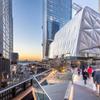William Eggleston's Extraordinary Color Photographs Series, Los Alamos, to Be Shown in Its Entirety at The Met
- NEW YORK, New York
- /
- December 27, 2017
The American photographer William Eggleston (born 1939) emerged in the early 1960s as a pioneer of modern color photography. Now, 50 years later, he is widely considered its greatest exemplar. Opening February 14 at The Metropolitan Museum of Art, William Eggleston: Los Alamos features a landmark gift to the Museum by Jade Lau of the artist’s most extraordinary portfolio, Los Alamos, comprising 75 dye-transfer prints from color negatives made between 1965 and 1974. The exhibition marks the first time the series will be presented in its entirety in New York City.
Los Alamos includes the artist’s first color photograph—Untitled, Memphis, 1965—a study of a young clerk pushing a train of shopping carts at a supermarket in Memphis, Tennessee. The image takes full advantage of the chromatic intensity of the dye-transfer color process that, until Eggleston appropriated it in the 1960s, had been used primarily by commercial photographers for advertising and product photography.
The exhibition includes lush color studies of the social and physical landscape of the Mississippi delta region, which remains the artist’s home, as well as studies made during numerous road trips with his friends Walter Hopps and Dennis Hopper—to New Orleans, New Mexico, Las Vegas, Los Angeles, and elsewhere. On these journeys, the artist explored the awesome and, at times, raw visual poetics of the American vernacular. Eggleston named this extensive body of work—which comprises some 2,000 photographs—after the famous government research facility in New Mexico where atomic weapons were developed. Driving past the Los Alamos National Laboratory in 1973, he turned to Hopps, smiled, and said, “You know, I’d like to have a secret lab like that myself.” As Hopps later wrote, the “title cloaks with some irony Eggleston’s ostensible subjects, found in a vast American terrain, yet acknowledges his belief in the aesthetic consequences of his private quest.”
Los Alamos is the work of an idiosyncratic artist whose influences are drawn from disparate but surprisingly complementary sources—from Walker Evans and Henri Cartier-Bresson in photography to Bach and the late Baroque in music. As much as Eggleston was influenced by various sources, he, too, has proved influential. His inventive photographs of commonplace subjects now serve as touchstones for generations of artists, musicians, and filmmakers— from Nan Goldin to David Byrne, the Coen brothers, and David Lynch.
The exhibition will also include as a counterpoint a small suite of Eggleston’s rarely seen black-and-white photographs from the mid-1960s to the early 1970s that the artist made concurrently with Los Alamos. Eggleston commented to his friends that he thought his photographs were “parts of a novel I’m doing”—one of the artist’s most seductive and now renowned comments on his aesthetic practice and ambition.
The exhibition is made possible in part by Deborah and Jonathan Klein.
William Eggleston: Los Alamos is organized by Jeff L. Rosenheim, Joyce Frank Menschel Curator in Charge in the Department of Photographs at The Metropolitan Museum of Art.
The exhibition will be featured on The Met website















